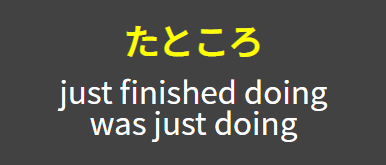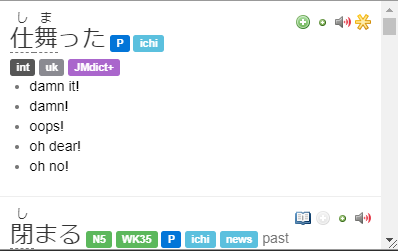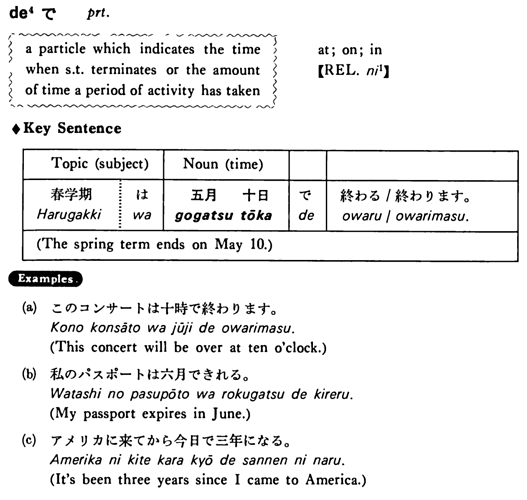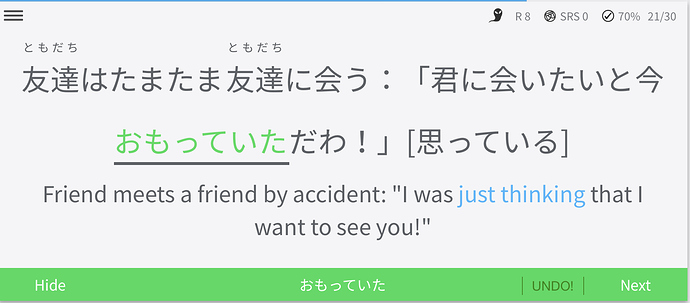According to Dictionary of Japanese Grammar, で can be used to indicate the time when s.t. terminates or the amount of time a period of activity has taken, which seems to fit well here.
Heya, I was wondering about the following sentence:
According to the grammar point, たところ itself can mean “just finished”.

So why is 終わる there?
Is the sentence literally implying that I just finished finishing my meal?
Or would 今食べたことろです imply the same thing?
(Furthermore, 今 combined with a past tense already implies the described part in the sentence “just” happened, so wouldn’t 食べたことろです suffice as well?)
@Pep95 Hey! 食べ終わったところ is close to the English “I just finished eating,” while 食べたところ is “I just ate.” It is just a matter of what you would like to express. They both mean essentially the same thing here. Cheers!
I think this review sentence is using grammar ahead of its lesson: [~てしまう]
旅行に行ったところに、台風が来てしまった。
Just as I had gone on a trip, a typhoon unfortunately came.
And as usual my 英和辞典 was more confusing than help full haha! xD

Hey 
Thank you for the feedback!
I have replaced all sentences that were using grammar points that appear later than たところ!
Cheers,
I don’t understand why this won’t accept 思っていたところ as an answer. The sample sentence uses a similar form.
Hey 
It was a bug and has been fixed thanks to your feedback.
Thank you and sorry for the inconvenience! 
I found this sentence in a JLPT N3 book and たとことdoesn’t seem to mean “just finished doing” in this case. What’s the meaning of this:
先輩に仕事をお願いしたとこと、気持ちよく引き受けてくれました。
@mrthuvi
Hey,
In this case (when AところB is used without any particle and B is generally in past form), it means “when/then” (the result of A is B/B has been triggered by A, but B happened by chance, not due to the will of the speaker). と and ったら can be used this way too.
Another example:
アプリを試したところ、エラーが出ました。
When I tried the app, I got an error.
B happened as a result of A, but was beyond the will of the speaker. Notice that actions of others are also beyond the will of the speaker.
I’m having trouble with differentiating ていたところ and ながら。 In the example sentence:
服を脱いでいたところに、母が部屋に入ってきた is translated as:
My mom came into the room just as I was taking my clothes off.
This seems to indicate the action is ongoing, rather than just completed. Why can’t I use ながら here?
Thanks!!
Larry
EDIT: corrected grammatical mistake regarding ながら
Your example sentence means explicitly at the moment you got undressed your mum entered (lol). It does not mean that at some point during the time it took you to get undressed she entered.
服を脱 いでいたところ に、母が部屋に入ってきた
My mum entered at just the moment I was getting undressed.
服を脱 ぎながら、母が部屋に入ってきた
My mum entered while she was getting undressed. ながら always refers to the same subject for both clauses.
たところ means precisely at the same moment as A, B happened.
ながら means that at some undefined point during A, B also happened. Must be the same subject for both clauses.
39, @nekoyama
Thanks so much!! My main textbook is “Japanese for Busy People” (and Tae Kim) but I’m doing the grammar in Bunpro order, so I get things out of sequence sometimes.
ながら expresses simultaneous actions by the same subject. So now the mother is the one who is undressing.
Ah yes, good point. That makes the sentence a whole new level of WTF
Can anyone explain to me when I would use a で/に after ところ?
Looking at the examples, I see some have で/に and some don’t and I can’t discern a pattern.
For example, in this example I put 渡したところで but it was marked as incorrect.
Hey! (Will add examples soon)
Think of ところ as “stage” in which action is. You can liken it to a frame of a movie, for example,
食べるところだ is a frame where you are about to eat, 食べているところだ is a frame when you are eating (have the meal in your mouth for example) and finally, 食べたところだ is a frame when you are finished (and the food is in the belly).
When we have ところ covered we can think about the particles.
When we have a sentence of Verb[ている]ところ PARTICLE + B type, which is usually used to say that something (B) happened when we were doing Verb[ている]the particle we choose will depend on the main verb in (B).
So with verbs like いく、くる、起こる we use Verb[ている]ところに(ところへ)。
ドアに鍵をかけているところに、急にドアが開いて妹が入ってきた。
ホラー映画を見ていたところに父さんが帰って来た。
With verbs like 見る、書かれる、見つける、想像する and so on we use Verb[ている]ところを。 It usually depicts some kind of scene. When used with passive verbs, it has negative nuance - “unluckily”.
女の子と歩いているところを見られた。
I was (unluckily) seen walking with a girl.
空手の練習をしているところを見つけた。
I have seen her/him training karate.
Those patterns are also used with Verb[ていた].
目上の人に尋ねる:「お急ぎのところを恐縮ですが、このプロジェクトについてのご意見をお聞かせ願えませんか」
Asking a superior: “I hate to trouble you when you are in such a hurry, but could you let me hear your opinion about this project?”
When the verb is in the past tense (Verb[た]), and something happened soon after it we use ところで。
デパートに問い合わせてみたところで、初めてその品物は売り切れだとわかった。
ところで is also used in the pattern ところで〜ない, meaning “even if” to express impossibility strongly. It is
徹夜して勉強したところで、合格しない。
Even if I studied all night, I would not pass.
「 謝ってみたところで、 彼女が許してくれるわけじゃないけど。」
“Even if I try to apologize, it doesn’ t mean she will forgive me.”
It can be used in all kinds of negative context, even if negative verb is not used, for example:
デパートに問い合わせてみたところで、その品物は売り切れだろう。
Often together with expressions like だろう、無駄だ and so on.
ところで、パソコンの使い方をご存知ですか。
By the way, do you know how to use a computer?
ところで、内本さんはどこ出身?
By the way, where is Uchimoto-san from?
日本のチームが勝つと思っていた。ところが負けてしまった。
I thought that the Japanese team would win. However, they lost.
新しいおもちゃを渡したところが壊れてしまった。
Just after I gave the new toy to (him/her), it broke.
(Yes, in this example you can use both で and が with different nuances, the first one focuses on it breaking immediately after giving the toy, the が version focuses on the unexpected result. I added てしまう because it is often used with ところが)
The last pattern is Verb[た」 ところ、(B) without any particles, where ところ means “when”. It is similar たら (when).
本人に聞いたところ、自分でやったと言いました。
When I asked the person in question, she said that she had done it herself.
Thank you for the detailed explanation!
Is 服を脱いでいたところ に、母が部屋に入ってきた intentionally listed under this grammar point rather than ているところだ (JLPT N4) | Bunpro – Japanese Grammar Explained this one?
It’s quite a bit confusing to see that the structure is Verb[た](1) + ところ + だ, but not a single example sentence in description has だ and never explains that it can be omitted to sound more natural. I had to double-check with third party resources as it definitely confused me.
I just came across this one and when I asked some teachers they said that ぬいでいるところに would be more natural.





